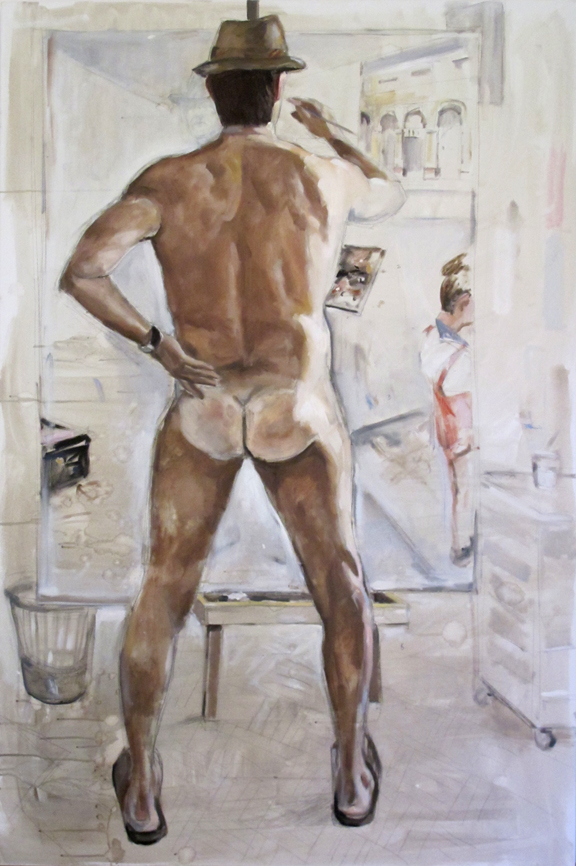Being Sadko Hadzihasanovic (Viewer Discretion Advised)
Sadko Hadžihasanović
May 19 - May 31, 2010

For over half his life and for most of his professional career Sadko Hadzihasanovic has explored the figure, the nude, in portraits of himself and of others. Twenty years ago while still living in his native Sarajevo and only two years before the outbreak of a devastating civil war, Hadzihasanovic painted his first nude self-portrait. In rendering this work he worked consciously against the traditions of the heroic or ideal nude. His self-portrait was a fragmentary vision, a conceptual metaphor for the vulnerability and fragility of the artist, of an individual, when confronted with the overwhelming violence of war.
Now, twenty years later, from the perspective of a man at the half-century mark in his life, Hadzihasanovic revisits the imagery of the nude self-portrait. These new paintings are more introspective, with the figure cast as a vessel for emotional state of being fragility, weakness, humanness - not caught in the forefront of war but of the inevitable passages of time. Yet inherent within them as well is a sense of humour and of humility. Hadzihasanovic's work is not a maudlin pining for days gone by but represent a remarkably honest documentation and celebration of the "self" - his self, revealed in its totality for all to see.
In contemporary self-portraiture depictions of the male nude are exceedingly rare, especially within the painting milieu. It is more popular as a vehicle by photographers such as Robert Mapplethorpe yet even then, self-portrait depictions are few and far between. It is interesting that this is so as the self-portrait is the artist's most personal form of expression. It is the ultimate means of self-analysis, presenting an opportunity for self-reflection, self-expression and self-promotion. Hadzihasanovic cites this discrepancy himself. He has stated that while reading recently about Pierre Bonnard?s late portraits, that the German critic Paul Westheim introduce a category in art called SELBST-KUNST(self-art) in 1920. Self-art refers to the importance of psychological and emotional states of being as transmitted through the use of self-portraiture, to communicate states of being as the most important aspect rather than focusing on physical representation. Using that framework and definition Hadzihasanovic's work can be looked at within the framework of self-nude art.
In one painting Hadzihasanovic slyly references the Apollo Belvedere sculpture which for centuries was held up as the idealized male figure. The sculpture is nude, save for a loose cape draped around his shoulders and arm. In Hadzihasanovic's work, the figure (his figure!) strikes a similar pose, clad in nothing but black ankle socks, a wristwatch and necklace. For all the intensity and "heroic" drama of his pose one cannot help but think of this as a kind of latter day version of Tom Cruise dancing in his underwear in Risky Business - but in this case it's an almost naked man channelling his best John Travolta dance move behind closed doors. Instead of the ideal youthful physique however we are given an honest depiction of a man of fifty, who is not trying to disguise the fact that he is no longer a youth. It is a moment of intimate, honest and ordinary nakedness. Which directly relates to the subtitle of Hadizhasanovic's work Viewer Discretion Advised.
It is not difficult to find depictions of nudity within contemporary culture. Often it is titillating, idealized, explicit or any combination of the three. But there are not that many images of normal, everyday moments of nakedness around. Even now, breast-feeding women are banished from restaurants and warning labels adorn walls in art exhibitions and theatres, allowing people to protect themselves from unintentionally seeing an exposed body part. The casualness of the environment that Hadzihasanovic depicts himself in however eliminates any possible "titillation" and removes the judgemental factor from today's figure-obsessed world. Instead he reveals himself honestly and aesthetically to the viewer. One sees him in terms of identity (the artist) but also the real body itself. By doing so, and through his employ of a mirthful tongue-in-cheek attitude, the works reveal the true nature of and contemporary attitudes towards human anatomy. The "heroic" nude in art is subverted by the "ordinary" nude guy completing a painting or dancing in his bedroom.
There is nothing ordinary about Hadzihasanovic's adeptness and facility in handling paint however. Academically trained his sense of colour, brushwork and evocation of the bodily form are graceful and masterly. There is a beautiful fluidity in these renditions. In his work colour and tonal relationships blend together to create an evocative composition. Mellow colours allow one form to merge with another embuing the works with a sense of loose, fluid life. Virtuoso brushwork and handling of colour and tone retain the artist's trademark freshness and contemporary feel.
On the surface, one might assume in hearing that in an exhibition of nude, self-portrait paintings that there would be little that could be read as a critique on our contemporary state of being. But that is exactly what Hadzihasanovic achieves. With passionate thinking, art making, and truth of vision, combined with brilliant methods of handling paint and depicting figuration, the artist succeeds in ushering in new ways of perceiving the pictures produced and the messages inherent within them. In the personal, the autobiographical, he taps into a stream of our current cultural psyche. "Here I am!" the paintings proclaim. And we the viewer are compelled to look - blatantly and with no discretion at all.
By Virginia Eichhorn







